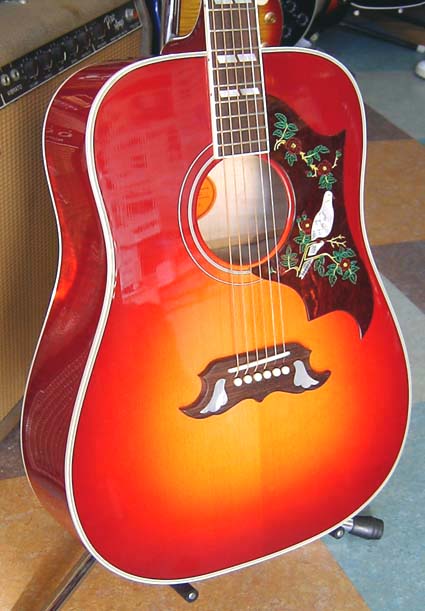It stars Sean Young (“Blade Runner”), David Della Rocco (“The Boondock Saints”), Lou Beatty Jr. (“Fast & Furious,” “Fight Club”) and singer-songwriter John Brannen (“Somebody”).
The film is about an ex-con (Brannen) trying to revive his music career and patch things up with his daughter, who has his black Gibson Dove guitar. Mike Caporale wrote the screenplay and is producing the movie.
What a great lead-in for a great guitar story.
Many TV stations throughout the nation produced local country western shows. The Country singers all liked their guitars to look fancy and the 1962 Gibson Dove was a beauty.
The Dove guitar was first made in the Kalamazoo, Michigan site, which was the home of Gibson Guitars.
It was Gibson's second square shouldered guitar. The first square shoulder model was the Hummingbird. Both instruments were based on Martin's popular Dreadnought guitar shape.
Although the Hummingbird and the Dove appeared to be similar instruments except for the differing fancy pickguards, they were really quite different. Both had solid spruce tops, but while the Hummingbird used solid mahogany for it's sides and back, the Dove utilized solid maple sides and back. Gibson used a lot of maple, perhaps because it was locally grown and readily available.
The Dove had a 25.5" scale from the nut to the bridge saddle, while the Hummingbird's scale was 24 3/4".
The neck scale and the use of maple gave the Dove a brighter and louder sound. The Doves neck itself was made of 3 pieces of maple which provided strength. The neck was capped with either an ebony or rosewood fretboard.
A mother of pearl Dove is also inlaid on the engraved and highly figured pickguard.
In 1970 Gibson redesigned the bridge and saddle utilizing a non-adjustable slanted bridge. They also simplified the bridge. Originally the Dove bridge was beveled on either side and was routed out for placement of the "doves".
The 1970 bridge retained the downward mustache shape, but had no bevel, nor did it have the two additional dot inlays.
The bound neck on the Dove bore double parallelogram fingerboard inlays as fretboard markers which started at the first fret.
In 1968, to the detriment of the instrument, the internal bracing of the Dove was made heavier. Although this made for a sturdier guitar and brought less warranty work to Gibson, the tone and volume suffered. When Gibson was purchased in 1985, the new owners began to address the quality of Gibson products. The bracing was changed back to it's original construction
In 1970 Gibson changed the guitar's name to the Gibson Dove Custom.
In 1992 Gibson moved it's acoustic instrument production site to Bozeman Montana and the Dove was a regular production item up until 1996. Although it could be custom ordered, it did not make it back into the line-up until 2007 as one of Gibson's Modern Classic Guitars.
The Modern Classic Gibson Doves featured bone nuts and Tusq bridge saddles. There was a new neck radius as well that set the action lower. Some have complained these features caused volume problems.
Although Gibson did custom orders and one-offs, the standard finish for the Dove was either Cherry sunburst or natural through 1986. In 1987 through 1993 Doves were only produced with a natural finish. In 1994 through 1996 they were available in Cherry sunburst again. The standard color for the back and neck of the Dove was a transparent cherry finish.
The body and neck bore a glossy black finish.
Elvis placed a Kenpo Karate decal in the center of the body's lower bout. The truss rod cover on the neck was also black.
Gibson in cooperation with Elvis Presley Enterprises now offers the Elvis Presley Dove in it's current line-up with a street price of around $2900 which is probably at least 10 times as much as they cost in 1962. You are going to have to find your own Kenpo Karate decal as this is not included. You'll need to purchase your own matching jumpsuit.
Starting in 1985 Gibson did offer some custom models starting with the 90th anniversary Dove model.
The current standard Dove model was available from Gibson for street price of $2900 at this writing.
Gibson's Epiphone division also produces the Epiphone Dove. This is a replica of the Gibson Dove and comes with a solid spruce top and laminated mahogany back and sides.
 |
| Epiphone Black Dove |
The suggested price for this guitar is $490 with a street price of $299.














5 comments:
awesome post, those sunburst doves are glorious!
Absolutely Mike,
The Gibson Dove is one of the most beautiful guitars out their, especially the cherry sunburst.
Gorgeous!
~Marc
UPDATE on the Black Dove Movie: John Savage replaced John Brannen as the film's lead, and he's awesome. You can find out more at www.theblackdovemovie.com
QUANTUM BINARY SIGNALS
Professional trading signals delivered to your cell phone daily.
Follow our trades NOW and earn up to 270% per day.
did the gibson or the epiphone dove ever deviate from the open book headstock? i seen one for sale and it had a squarish topped headstock. thank you
Post a Comment